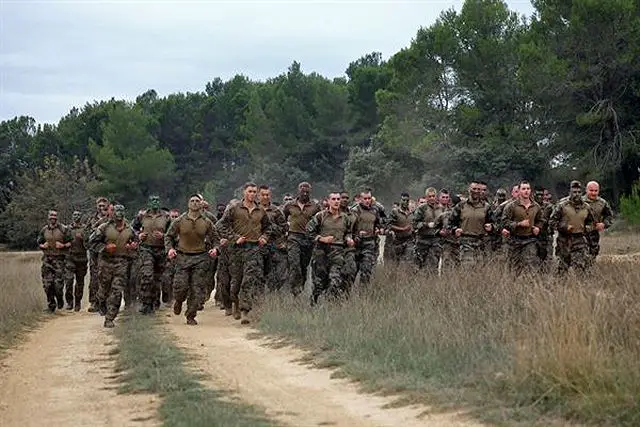Joint military training exercise France U.S. Marines French Army Foreign Legion soldiers 0611133
| a | |||
U.S. Marine and French Army Foreign Legion |
|||
| Wednesday, November 6, 2013 11:58 AM | |||
| Joint military training exercise in France for U.S. Marines and French Army Foreign Legion soldiers. | |||
U.S.
Marines with Special-Purpose Marine Air-Ground Task Force Crisis Response,
the Marine Corps’ newest unit, spent Oct. 28 to Nov. 1 near Camp
des Garrigues, France, training with Legionnaires from France’s
2nd Foreign Infantry Regiment. |
|||
| |
|||
 Marines and sailors with Special-Purpose Marine Air-Ground Task Force Crisis Response and Legionnaires from the 2nd Foreign Infantry Regiment of France's 6th Light Armored Brigade work side-by-side during a simulated heliborne raid Oct. 31, 2013, at Camp des Garrigues, France. |
|||
| |
|||
The week-long bilateral event was the first between SP-MAGTF Crisis Response and the French military and served to establish professional, working relationships between the allied nations. The event culminated Thursday, Oct. 31, as Marines and Legionnaires took to the skies in a MV-22B Osprey, landing just outside a fenced-in compound that served as the day’s objective. The infantrymen assaulted through the compound, communicating and working together as they maneuvered around and through dozens of metal warehouses, concrete urban structures and danger areas, such as road intersections and open fields. All this while fighting a simulated opposing force of fellow Marines and Legionnaires hidden throughout the compound and engaging with blank ammunition to re-create the sounds and smells of the battlefield. The training scenario ended after the force worked its way through a final building, using room-clearing tactics and techniques to eliminate the enemy forces inside. |
|||
 Legionnaires from the 2nd Foreign Infantry Regiment of France's 6th Light Armored Brigade set up landing zone security for an MV-22B Osprey with Special-Purpose Marine Air-Ground Task Force Crisis Response Oct. 30, 2013, at Camp des Garrigues, France. |
|||
Although
the Marines and Legionnaires had not trained together before the week
began, the assault was a success, mainly due to the striking similarities
between the two military organizations.
Marine Capt. Jackson Smith, the executive officer of Alpha Company, 2nd Reconnaissance Battalion, SP-MAGTF Crisis Response, was asked whether he would be comfortable in a future combat situation with a foreign force. His answer came quickly: “If it was with these guys — I’d go anywhere with these guys,” he said. Smith’s statement captured the sentiment of most of the infantry Marines involved in the exercise. But SP-MAGTF Crisis Response didn’t only bring its infantry to France. They also brought an MV-22B Osprey — the first to ever operate tactically in an exercise on French soil. “It was a great week — the U.S. has a long and valued history with France and we hope we can get together with them for follow on training,” said Capt. Kyle Stuart, an MV-22B Osprey pilot with Marine Medium Tilitrotor Squadron 162, SP-MAGTF Crisis Response. Stuart said it was a neat experience to be the first pilot to fly an Osprey to France as part of an exercise, but the honor belongs to his squadron, VMM-162, and the Marines and sailors of SP-MAGTF Crisis Response. The MV-22B Osprey adds a significant capability to the operations of SP-MAGTF Crisis Response not enjoyed by other military organizations throughout the world. The Ospreys are organic to the unit, which means they directly support all Crisis Response forces — an essential characteristic for a unit whose mission is to provide a quick-deploying force to support potential crises as directed over large areas in U.S. Africa Command. |
|||
 U.S. Marines with Special-Purpose Marine Air-Ground Task Force Crisis Response and Legionnaires with the 2nd Foreign Infantry Regiment of France's 6th Light Armored Brigade take part in a 7K obstacle course after conducting a heliborne raid Oct. 31, 2013, at Camp des Garrigues, France. |
|||
Because
of that mission, the Marines in France were only a contingent from SP-MAGTF
Crisis Response, as most of the unit remains on constant alert at Moron
Air Base, Spain, where the unit is temporarily based.
“Our unit’s alert status can make it a challenge to get away and do these types of events,” said Capt. T. D. McAbee, the officer-in-charge of the exercise for the Marines. “But bilateral exercises are integral for maintaining our ability to focus on our mission and sharpen our skills while fostering improved military relations with our sister nation’s militaries.” The Legionnaires hosted a 7K obstacle course as the final event of the week, but instead of competing against each other — as would seem natural for two militaries with histories as storied as these — the two units joined forces and finished together. Afterward, there was a gift exchange followed by food and drinks, capping a successful week of training. Both Marines and Legionnaires said they gained many things, each remarking how their standards of discipline and camaraderie along with their warfighting traditions provide a strong link between the two. Both hope for an opportunity to train again soon. SP-MAGTF Crisis Response returned to Spain after the exercise, and has plans for more bilateral training with their partners in the Spanish military in the coming weeks. |
|||


























